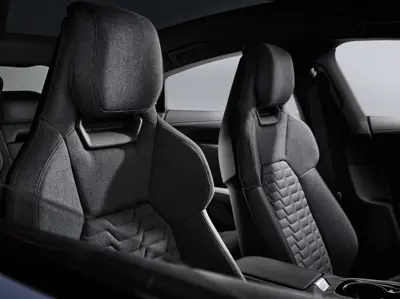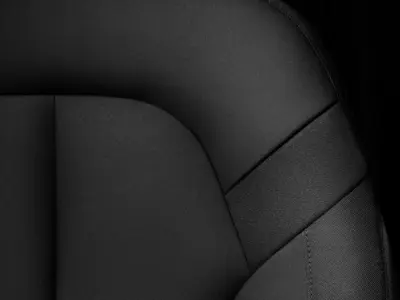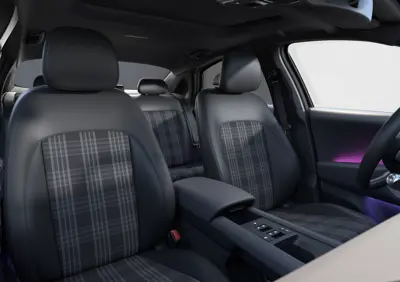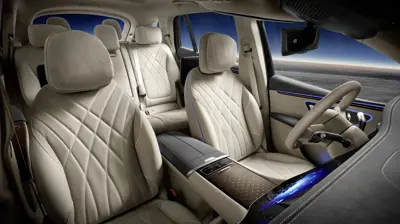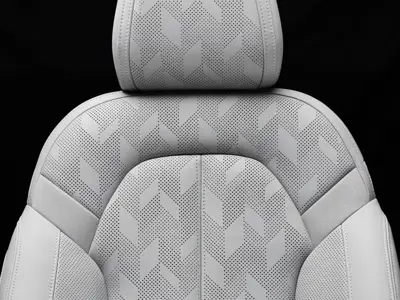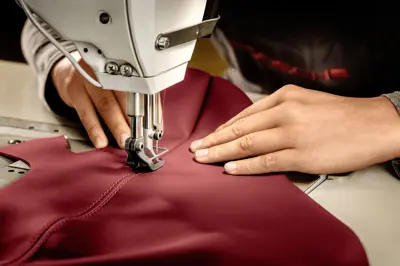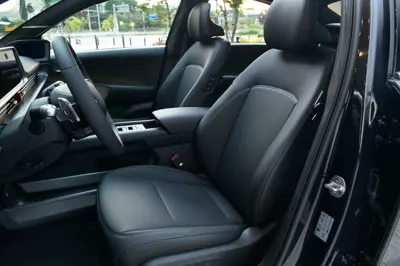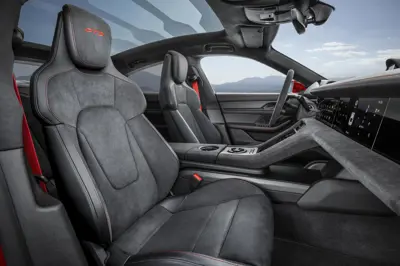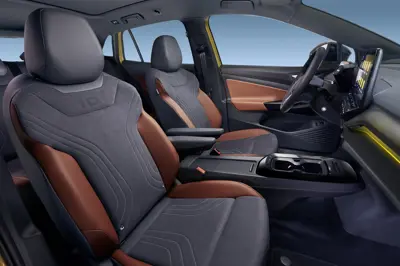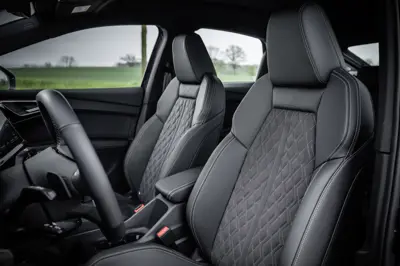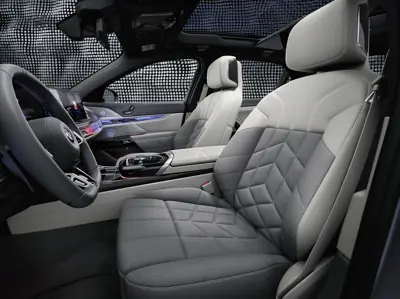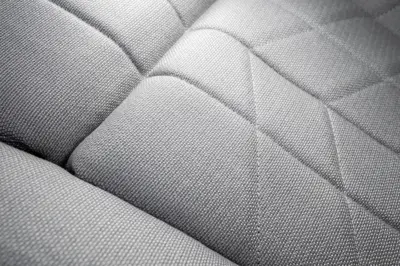Seat Upholstery & Materials
Car seat upholstery is an essential aspect of car seat design and can impact the comfort and aesthetic appeal of a car's interior. EV manufacturers commonly use several materials for car seat upholstery, each with pros and cons.
Last modified: Jan 01, 2025Sustainability and ethical considerations are essential for many people when choosing seat upholstery materials, including leather. Recently, there has been an increasing demand for vegan or cruelty-free alternatives to traditional leather due to concerns about animal welfare, environmental impact, and sustainability. We cover this for each type of seat upholstery.
The materials covered are:
Fabric
Fabric is a popular material used for seat upholstery. It is versatile, available in various colors, textures, and patterns, making it easy to find the perfect look for your car. "Cloth" and "fabric" are often used interchangeably to describe the material used for upholstery. Cloth or fabric car seats are typically made from woven or knit textiles, such as polyester, nylon, or a blend of synthetic and natural fibers.
Pros of Fabric Seat Upholstery
- Cost: Fabric is more affordable than leather or other premium materials, making it an excellent option for those on a budget.
- Comfort: Fabric seat covers are comfortable and breathable, providing a soft and supportive surface for the driver and passengers.
- Aesthetics: Fabric comes in various colors and patterns, allowing you to choose the perfect look for your car’s interior. It is a versatile material that can match any style or design.
Cons of Fabric Seat Upholstery
- Durability: Fabric is less durable than leather or other materials. It can be prone to wear and tear and may not hold up well over time.
- Stains: Fabric is more susceptible to stains and spills than other materials, which can be a concern if you have children or pets.
- Allergens: Fabric can trap allergens like dust and pet dander, making it a less suitable option for those with allergies.
Types of Fabric
- Nylon: A durable and affordable fabric often used in entry-level vehicles. It is resistant to wear and tear, making it a practical choice for those who prioritize durability.
- Polyester: A synthetic fabric that is resistant to stains and fading. It is a popular choice for those who prioritize low maintenance.
Sustainability of Fabric Seat Upholstery
The production of fabric can significantly impact the environment, including water and energy use, greenhouse gas emissions, and waste. However, sustainable practices in the fabric industry can mitigate these impacts.
- Eco-Friendly Processes: Choose materials produced using recycled materials, organic cotton, or fabrics certified by sustainability organizations.
- Ethical Practices: Choose fabric from companies that ensure fair treatment of workers and responsible sourcing of materials.
In the video below, you can see how Audi creates their sustainable seats from reusable materials like bottles.
Leather
Leather has been a popular material for seat upholstery for many years. It is a luxurious and durable material that can add a touch of elegance to any car’s interior. However, there are pros and cons to using leather, and there are different types of leather to consider.
Pros of Leather Seat Upholstery
- Durability: Leather is a durable material that can last for many years with proper care. It is resistant to wear and tear and can withstand spills and stains better than other materials.
- Comfort: Leather seat covers are comfortable and soft to the touch, providing a comfortable and supportive surface for the driver and passengers.
- Aesthetics: Leather has a classic and luxurious look that can enhance the interior of any vehicle. It comes in a range of colors and textures, allowing you to choose the perfect look for your car.
- Resale Value: Vehicles with leather upholstery tend to have a higher resale value than those with fabric upholstery. Leather is a premium material that can add value to your car.
Cons of Leather Seat Upholstery
- Cost: Leather is more expensive than other options, such as fabric or vinyl.
- Maintenance: Leather requires regular maintenance to keep it looking its best. It needs to be cleaned and conditioned regularly to prevent cracking and fading.
- Temperature Sensitivity: Leather can be hot in the summer and cold in the winter, making it uncomfortable for some people.
Types of Leather
- Nappa Leather: A premium type of leather that is soft and supple to the touch. It is made from sheep or lambskin and is often used in high-end luxury vehicles. Nappa leather is more expensive but also more durable and luxurious.
- Full-Grain Leather: The highest quality leather available, made from the top layer of the animal hide and retaining its natural grain and texture. Full-grain leather is durable and develops a unique patina over time.
- Top-Grain Leather: Made from the second layer of the animal hide, it is thinner and more pliable than full-grain leather. It is often used in mid-range vehicles.
- Bonded Leather: A synthetic material made from scraps of leather bonded together. It is less expensive than genuine leather but is not as durable or luxurious.
Sustainability of Leather Seat Upholstery
The production of leather can significantly impact the environment, including deforestation, water pollution, and greenhouse gas emissions. However, sustainable practices in the leather industry can mitigate these impacts.
- Environmentally Friendly Processes: Some companies use vegetable-tanned leather, which uses natural materials like tree bark to tan the leather instead of toxic chemicals.
- Ethical Practices: Choose leather from companies that ensure humane conditions for animals and fair treatment of workers. The Leather Working Group is a global multi-stakeholder community committed to building a sustainable future with responsible leather, and several car manufacturers are part of it.
In conclusion, leather seat upholstery can add a touch of luxury to any car’s interior. However, it is important to consider the pros and cons of using leather, as well as the different types of leather available. Additionally, it is crucial to choose leather that is produced using sustainable and ethical practices to minimize the impact on the environment.
Leatherette
Leatherette is a synthetic material designed to mimic the look and feel of real leather. It is commonly used for car seat upholstery due to its affordability and ease of maintenance. Below, we explore the pros and cons of leatherette and its sustainability.
Pros of Leatherette Seat Upholstery
- Cost: Leatherette is generally less expensive than real leather, making it a budget-friendly option.
- Durability: It is a robust material that can withstand wear and tear, as well as resist stains and spills.
- Easy Maintenance: Leatherette is simple to clean and maintain, often requiring just a damp cloth or mild detergent.
- Aesthetics: Available in various colors and textures, leatherette can easily match your car's interior design.
Cons of Leatherette Seat Upholstery
- Breathability: Leatherette is less breathable than real leather, which can lead to discomfort in hot weather and during long drives.
- Comfort: While durable, leatherette may not be as comfortable or pliable as natural leather.
- Environmental Concerns: Made from synthetic materials, leatherette is not biodegradable and can contribute to pollution. Its production may also involve harmful chemicals.
Types of Leatherette
- Vinyl Leatherette: The most common type, made from plastic and typically the least expensive.
- PVC Leatherette: More durable and resistant to scratches and tears, also more flexible than vinyl.
- Polyurethane Leatherette: The most luxurious type, with a soft texture resembling natural leather, but also the most expensive.
Sustainability of Leatherette Seat Upholstery
The sustainability of leatherette is complex. While it avoids the environmental impact of real leather production, it is made from non-biodegradable synthetic materials. However, some manufacturers are adopting eco-friendly practices, such as using recycled materials or biodegradable options to reduce environmental impact.
Microfiber
Microfiber is a synthetic material known for its durability, stain resistance, and ease of maintenance. Here, we discuss the pros and cons of microfiber, the types used, and its sustainability.
Pros of Microfiber Seat Upholstery
- Durability: Resistant to wear, stains, fading, and pilling, making it ideal for daily use.
- Stain Resistance: Naturally resistant to stains and spills, easy to clean.
- Aesthetic Appeal: Offers a smooth, luxurious look in various textures and colors.
- Cost-Effective: Generally less expensive than leather or wool.
Cons of Microfiber Seat Upholstery
- Breathability: Not breathable, which can trap heat and moisture, causing discomfort.
- Environmental Impact: Made from petroleum products, non-biodegradable, and can take hundreds of years to decompose.
Types of Microfiber
- Polyester Microfiber: Commonly used, known for durability and affordability.
- Nylon Microfiber: Stronger and more abrasion-resistant, often used in high-end interiors.
- Microsuede: Suede-like texture, soft and durable, used in luxury interiors.
Sustainability of Microfiber Seat Upholstery
Microfiber's production involves non-renewable resources and is not biodegradable. However, some manufacturers are using recycled materials and eco-friendly practices to mitigate environmental impact.
Alcantara
Alcantara is a synthetic material made from polyester and polyurethane, resembling suede leather. It is often used in high-end cars for its luxurious feel. Below, we explore the pros and cons of Alcantara and its sustainability.
Pros of Alcantara Seat Upholstery
- Softness: Provides a luxurious, plush texture.
- Durability: Resistant to wear and tear, more durable than fabric and vinyl.
- Stain Resistance: Repels liquids and is easy to clean.
- Aesthetics: Available in various colors and textures.
Cons of Alcantara Seat Upholstery
- Cost: More expensive than fabric and vinyl.
- Allergens: Can trap dust and pet dander, less suitable for those with allergies.
- Environmental Impact: Made from petrochemicals, its production can release greenhouse gases and use non-renewable resources.
Sustainability of Alcantara Seat Upholstery
Alcantara production can impact the environment, but sustainable practices can mitigate these effects. Choosing materials produced using eco-friendly processes, such as recycled materials or certified by sustainability organizations, can help. Alcantara S.p.A., the sole manufacturer, has implemented sustainable practices, including a closed-loop production process and energy-saving measures.
In the video below, you can see a visit to the Alcantara factory.
Alcantara S.p.A. is the only company licensed to produce and market Alcantara products, working with a global network of partners and suppliers.
Dinamica
Dinamica is a synthetic suede-like material often used for seat upholstery. Made from polyester and polyurethane, it is designed to be an eco-friendly alternative to traditional suede. Below, we explore the pros and cons of using Dinamica for seat upholstery and its sustainability.
Pros of Dinamica Seat Upholstery
- Softness: Dinamica has a soft and luxurious texture that resembles natural suede. It is a popular choice for high-end cars and provides a premium look and feel.
- Durability: Dinamica is a durable material resistant to wear and tear. It is more durable than some other materials, including fabric and vinyl.
- Stain Resistance: Dinamica is stain-resistant and easy to clean. It repels liquids and can be easily wiped clean with a damp cloth.
- Aesthetics: Dinamica comes in a variety of colors and textures, making it easy to find a look that matches your car's interior.
Cons of Dinamica Seat Upholstery
- Cost: Dinamica is more expensive than some other options, including fabric and vinyl. This can make it a less desirable option for those on a budget.
- Allergens: Dinamica can trap allergens, including dust and pet dander, making it less suitable for those with allergies.
- Limited Availability: Dinamica is not as widely available as some other materials, which can make it difficult to source in certain areas.
Sustainability of Dinamica Seat Upholstery
Dinamica is marketed as an eco-friendly alternative to natural suede. Its production uses less water and energy than traditional suede and does not involve harmful chemicals such as chromium. Additionally, Dinamica is made from recycled polyester and is itself recyclable, reducing waste and minimizing environmental impact.
Dinamica has been certified by several sustainability organizations, including the Global Recycle Standard and the Oeko-Tex Standard 100, ensuring that the material has been produced using environmentally responsible processes and is free from harmful chemicals.
Dinamica is produced by the Italian company Miko S.r.l.. Founded in 1994 and based in San Giovanni Lupatoto, Italy, Miko specializes in the production of eco-sustainable materials. The company has implemented a range of environmentally sustainable practices in its production process, including the use of renewable energy and the recycling of waste materials. Miko has received several certifications for its commitment to sustainability, including ISO 14001 for environmental management and Oeko-Tex Standard 100 for the absence of harmful substances in its products.
Dinamica is used in a range of applications beyond automotive interiors, including furniture, fashion, and consumer electronics. It has become a popular choice for brands looking to use sustainable materials in their products. The Volkswagen group recently switched from using Alcantara to Dinamica.
Alcantara sued Miko for various claims about sustainability and won in 2021.
Wool
Wool is a natural fiber that has been used for centuries in clothing and textile manufacturing. It is also used in car seat upholstery due to its durability, comfort, and natural properties. Below, we explore the pros and cons of using wool for car seat upholstery, the different types of wool used, and its sustainability.
Pros of Using Wool for Car Seat Upholstery
- Durability: Wool is a naturally strong fiber that can withstand wear and tear. It is resistant to wrinkling, shrinking, and abrasion, making it an ideal material for car seat upholstery that is subject to daily use.
- Comfort: Wool is naturally soft and comfortable to sit on. It can also regulate body temperature, keeping you cool in the summer and warm in the winter.
- Aesthetic Appeal: Wool has a classic and sophisticated look that can enhance the overall aesthetic of a car's interior. It comes in a variety of textures and colors, making it a versatile material for upholstery.
- Fire Resistance: Wool is naturally fire-resistant, which is an important safety feature in a car's interior.
Cons of Using Wool for Car Seat Upholstery
- Cost: Wool is generally more expensive than other materials used for car seat upholstery, such as leatherette or microfiber.
- Maintenance: Wool requires special care to maintain its appearance and durability. It is recommended to dry clean wool car seat covers rather than washing them in a machine.
Types of Wool Used for Car Seat Upholstery
- Merino Wool: This is a high-quality wool that is soft and comfortable to the touch. It is known for its warmth, durability, and moisture-wicking properties.
- Cashmere Wool: This is a luxury wool known for its softness and insulating properties. It is more expensive than other types of wool and is often used in high-end car interiors.
- Shetland Wool: This is a coarser wool known for its durability and strength. It comes in a range of colors and is often used in tweed fabrics.
Sustainability of Using Wool for Car Seat Upholstery
Wool is a renewable resource that is sheared from sheep once a year, making it a sustainable material for car seat upholstery. It is also biodegradable and can be recycled at the end of its life. However, the environmental impact of wool production depends on factors such as the use of pesticides and the treatment of wastewater during processing. Some wool producers prioritize sustainability by using eco-friendly practices such as organic farming and water conservation.
Colors
Colors are an important aspect of seat upholstery materials, as they can significantly impact the overall appearance and style of your vehicle's interior. Different materials offer varying options for colors, allowing you to customize the look of your seats according to your preferences and the desired aesthetic.

